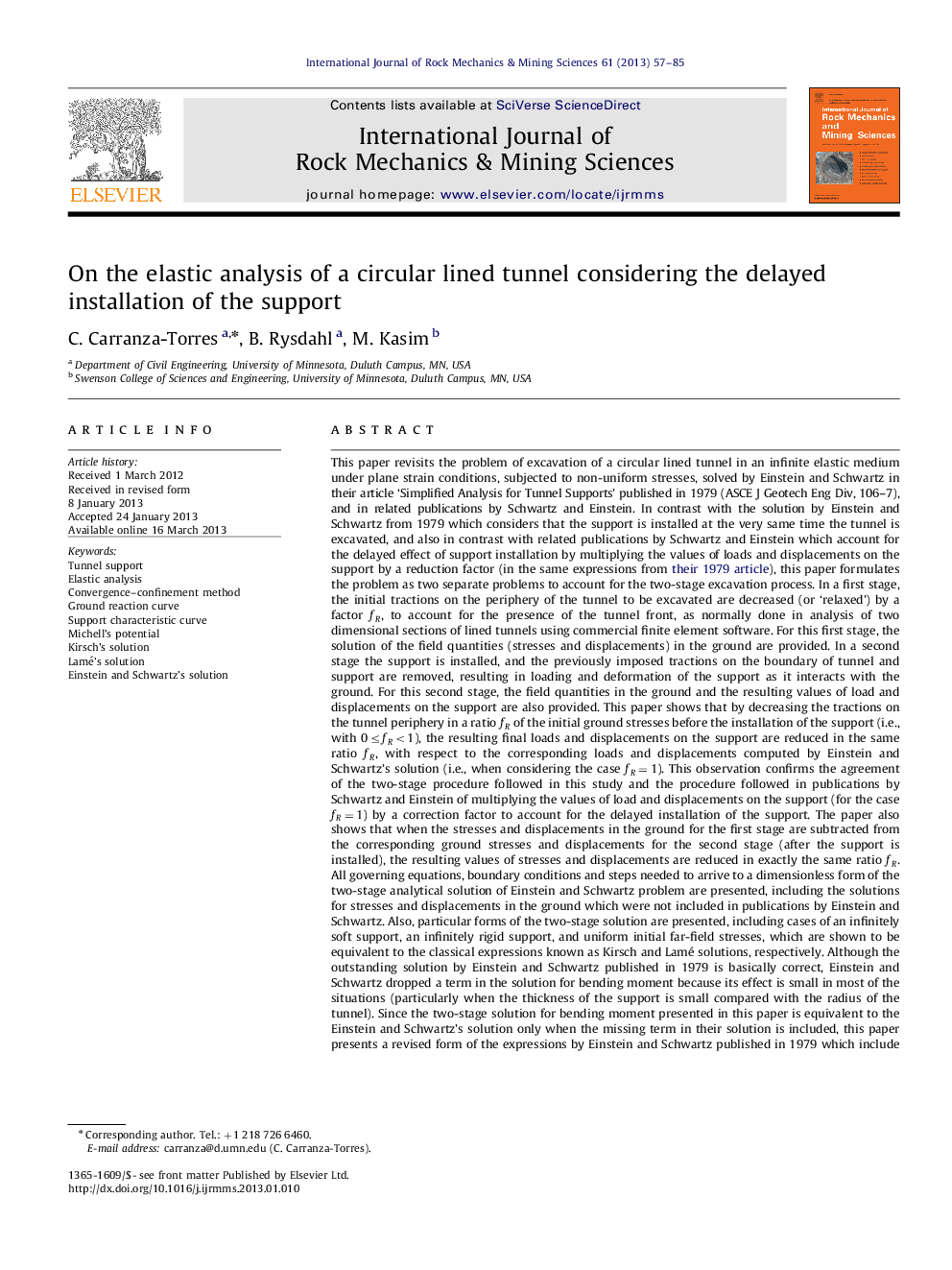| Article ID | Journal | Published Year | Pages | File Type |
|---|---|---|---|---|
| 809225 | International Journal of Rock Mechanics and Mining Sciences | 2013 | 29 Pages |
This paper revisits the problem of excavation of a circular lined tunnel in an infinite elastic medium under plane strain conditions, subjected to non-uniform stresses, solved by Einstein and Schwartz in their article ‘Simplified Analysis for Tunnel Supports’ published in 1979 (ASCE J Geotech Eng Div, 106–7), and in related publications by Schwartz and Einstein. In contrast with the solution by Einstein and Schwartz from 1979 which considers that the support is installed at the very same time the tunnel is excavated, and also in contrast with related publications by Schwartz and Einstein which account for the delayed effect of support installation by multiplying the values of loads and displacements on the support by a reduction factor (in the same expressions from their 1979 article), this paper formulates the problem as two separate problems to account for the two-stage excavation process. In a first stage, the initial tractions on the periphery of the tunnel to be excavated are decreased (or ‘relaxed’) by a factor fRfR, to account for the presence of the tunnel front, as normally done in analysis of two dimensional sections of lined tunnels using commercial finite element software. For this first stage, the solution of the field quantities (stresses and displacements) in the ground are provided. In a second stage the support is installed, and the previously imposed tractions on the boundary of tunnel and support are removed, resulting in loading and deformation of the support as it interacts with the ground. For this second stage, the field quantities in the ground and the resulting values of load and displacements on the support are also provided. This paper shows that by decreasing the tractions on the tunnel periphery in a ratio fRfR of the initial ground stresses before the installation of the support (i.e., with 0≤fR<10≤fR<1), the resulting final loads and displacements on the support are reduced in the same ratio fRfR, with respect to the corresponding loads and displacements computed by Einstein and Schwartz's solution (i.e., when considering the case fR=1fR=1). This observation confirms the agreement of the two-stage procedure followed in this study and the procedure followed in publications by Schwartz and Einstein of multiplying the values of load and displacements on the support (for the case fR=1fR=1) by a correction factor to account for the delayed installation of the support. The paper also shows that when the stresses and displacements in the ground for the first stage are subtracted from the corresponding ground stresses and displacements for the second stage (after the support is installed), the resulting values of stresses and displacements are reduced in exactly the same ratio fRfR. All governing equations, boundary conditions and steps needed to arrive to a dimensionless form of the two-stage analytical solution of Einstein and Schwartz problem are presented, including the solutions for stresses and displacements in the ground which were not included in publications by Einstein and Schwartz. Also, particular forms of the two-stage solution are presented, including cases of an infinitely soft support, an infinitely rigid support, and uniform initial far-field stresses, which are shown to be equivalent to the classical expressions known as Kirsch and Lamé solutions, respectively. Although the outstanding solution by Einstein and Schwartz published in 1979 is basically correct, Einstein and Schwartz dropped a term in the solution for bending moment because its effect is small in most of the situations (particularly when the thickness of the support is small compared with the radius of the tunnel). Since the two-stage solution for bending moment presented in this paper is equivalent to the Einstein and Schwartz's solution only when the missing term in their solution is included, this paper presents a revised form of the expressions by Einstein and Schwartz published in 1979 which include the missing term, and it examines what the effect of retaining or dropping the term is. Finally a comparison of results obtained with the two-stage analytical solution and the finite difference code FLAC3D is presented, together with the outline of a computer spreadsheet that implements the two-stage analytical solution of this fundamental problem of tunnel ground–support interaction analysis.
► Elastic ground–support interaction problem is solved using theory of elasticity. ► Ground stress relaxation prior to support installation is considered. ► Complete demonstration of solution and application examples are provided.
